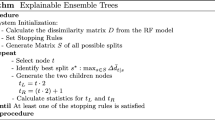Abstract
Obtaining an indication of confidence of predictions is desirable for many data mining applications. Predictions complemented with confidence levels can inform on the certainty or extent of reliability that may be associated with the prediction. This can be useful in varied application contexts where model outputs form the basis for potentially costly decisions, and in general across risk sensitive applications. The conformal prediction framework presents a novel approach for obtaining valid confidence measures associated with predictions from machine learning algorithms. Confidence levels are obtained from the underlying algorithm, using a non-conformity measure which indicates how ‘atypical’ a given example set is. The non-conformity measure is a key to determining the usefulness and efficiency of the approach. This paper considers inductive conformal prediction in the context of random tree ensembles like random forests, which have been noted to perform favorably across problems. Focusing on classification tasks, and considering realistic data contexts including class imbalance, we develop non-conformity measures for assessing the confidence of predicted class labels from random forests. We examine the performance of these measures on multiple data sets. Results demonstrate the usefulness and validity of the measures, their relative differences, and highlight the effectiveness of conformal prediction random forests for obtaining predictions with associated confidence.




Similar content being viewed by others
References
Basilico JD, Munson MA, Kolda TG, Dixon KR, Kegelmeyer WP (2011) COMET: a recipe for learning and using large ensembles on massive data. In: Proceedings of the 2011 IEEE international conference on data mining (ICDM 2011), pp 41–50
Bhattacharyya S, Jha S, Tharakunnel K, Westland JC (2011) Data mining for credit card fraud: a comparative study. Decis Support Syst 50(3):602–613
Breiman L (2001) Random forests. Mach Learn 45:5–32
Breiman L, Cutler A (2005) Random forest. http://www.math.usu.edu/~adele/forests
Caruana R, Karampatziakis R, Yessenalina A (2008) An empirical evaluation of supervised learning in high dimensions. In: Proceedings of the 25th international conference on machine learning (ICML ’08), pp 96–103
Chen C, Liaw A, Breiman L (2004) Using random forest to learn imbalanced data. Technical Report 666. University of California at Berkeley, Statistics Department 2004
Deodhar M, Ghosh J (2009) Mining for the most certain predictions from dyadic data. In: Proceedings of the 15th ACM SIGKDD international conference on knowledge discovery and data mining (KDD ’09), pp 249–258
Devetyarov D, Nouretdinov I (2010) Prediction with confidence based on a random forest classifier. In: Proceedings of AIAI, 2010, pp 37–44
Dietterich TG (2002) Ensemble learning. In: Arbib MA (ed) The handbook of brain theory and neural networks, 2nd edn. The MIT Press, Cambridge, MA
Gammerman A, Vovk V (2007) Hedging predictions in machine learning. Comput J 50(2):151–163
Heskes T (1997) Practical confidence and prediction intervals. Adv Neural Inf Process Syst (NIPS’97) 9:176–82
Hulse JV, Khoshgoftaar TM, Napolitano A (2007) Experimental perspectives on learning from imbalanced data. In: Proceedings of the 24th international conference on machine learning (ICML ’07), pp 935–942
Lambrou A, Papadopoulos H, Gammerman A (2011) Reliable confidence measures for medical diagnosis with evolutionary algorithms. IEEE Trans Inf Technol Biomed 15(1):93–99
Laxhammar R, Falkman G (2010) Conformal prediction for distribution-independent anomaly detection in streaming vessel data. In: Proceedings of the first international workshop on novel data stream pattern mining techniques (StreamKDD ’10), pp 47–55
Melluish T, Saunders C, Nouretdinov I, Vovk V (2001) Comparing the Bayes and typicalness frameworks. In: Proceedings of the 12th European conference on machine learning (EMCL ’01), pp 360–371
Papadopoulos H, Vovk V, Gammerman A (2007) Conformal prediction with neural networks. In: Proceedings of the 19th IEEE international conference on tools with artificial intelligence, vol 2, pp 388–395
Shafer G, Vovk V (2008) A tutorial on conformal prediction. J Mach Learn Res 9:371–421
Shrestha D, Solomatine D (2006) Machine learning approaches for estimation of prediction interval for the model output. Neural Netw 19(2):225–235
Statnikov A, Wang L, Aliferis CF (2008) A comprehensive comparison of random forests and support vector machines for microarray-based cancer classification. BMC Bioinf 9:319–324
Vens C, Costa F (2011) Random forest based feature induction. In: 2011 IEEE 11th international conference on data mining(ICDM, 2011), pp 744–753
Verikas A, Gelzinis A, Bacauskiene M (2011) Mining data with random forests: a survey and results of new tests. Pattern Recognit 44:2, 330–349
Vovk V, Gammerman A, Shafer G (2005) Algorithmic learning in a random world. Springer, New York
Whitrow C, Hand DJ, Juszczak P, Weston D, Adams NM (2009) Transaction aggregation as a strategy for credit card fraud detection. Data Min Knowl Discov 18(1):30–55
Wang B, Japkowicz N (2010) Boosting support vector machines for imbalanced data sets. Knowl Inf Syst 25(1):1–20
Wang H, Lin C, Yang F, Hu X (2009) Hedged predictions for traditional Chinese chronic gastritis diagnosis with confidence machine. Comput Biol Med 39:5, 425–432
Yang F, Wang H, Mi H, Lin C, Cai W (2009) Using random forest for reliable classification and cost-sensitive learning for medical diagnosis. BMC Bioinf 10(Suppl 1):S22
Author information
Authors and Affiliations
Corresponding author
Rights and permissions
About this article
Cite this article
Bhattacharyya, S. Confidence in predictions from random tree ensembles. Knowl Inf Syst 35, 391–410 (2013). https://doi.org/10.1007/s10115-012-0600-z
Received:
Revised:
Accepted:
Published:
Issue Date:
DOI: https://doi.org/10.1007/s10115-012-0600-z




